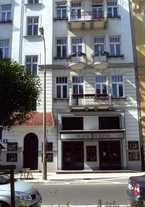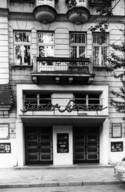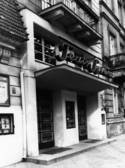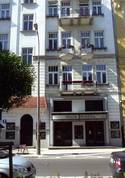Syrena Theatre (Siren Theatre)
ul. Litewska 3 | |
| Prikaži na zemljevidu. | http://teatrsyrena.pl/ |
Zgodovina
‘[The Syrena Theatre] is located in a beautiful six-storey tenement house from the turn of the 19th and 20th centuries. The tenement house has eleven axes of windows and is embellished with a bay window, running the height of the building. Everything, including the use of a horse as a decorative element, suggests that the building was erected to house a riding stable there – a school of horse riding called ‘tatersal’. In fact, there was a riding stable there, and at the beginning of the century it belonged to Konopacki. Between 1920 and 1925, advertisements publicising the ‘Nowy Tatersal’ riding school, with a large assortment of rideable horses, lessons in horse riding and ‘a boarding house for horses’ frequently appeared in the press. The proximity of Łazienki park, where special alleys for riding horses existed at that time, boosted the development of the enterprise. This status quo lasted until 1939; the building survived both the warfare in 1939, and the uprising in 1944.
As early as in November 1945, the Syrena Theatre, having come from Łódź and under the direction by Jerzy Jurandot, performed in a room of the Wedel factory on Zamoyski street. They had certainly planned to settle down in Warsaw from the very beginning. In order to accomplish this, the company had to find premises; they chose the former riding school.
The riding stable was transformed into the stage and the auditorium, whereas the stables were changed into workshops and storerooms; the dressing rooms were installed in the basement of the theatre building itself. The construction work, according to the design and under the guidance of engineer Espenhau, was completed in 1948. The new stage in the capital was inaugurated with a performance entitled New Pro-orders (Nowe pro-rządki)[1] by Gozdawa, Jurandot, Rudzki, Stępień and Tuwim on 2 December of the same year.
The impressive building still towers over Litewska street. The remaining element of its old use is a carved horse’s head, embellishing the bottom part of the bay window over the gate leading into the courtyard. In the gateway itself there are preserved remains of blue glaze with yellow medallions and a frieze depicting Roman coachmen and quadrigas in the upper part. Bars, mirrored panes in the inner doors, brass door handles and so on are also original elements.
In the courtyard there is the building of the old riding school, nowadays the stage and the auditorium of the theatre. It can easily be imagined as the high hall of the riding stable, horizontally divided by ceilings into the technical room under the stage, stalls, the balcony and the fly lot. The theatre is entered from the street through swing doors, which is the former entrance to the riding school. We enter a hall supported by two pillars, where the box office is also located. A few steps leads from here to the cloakroom, which is also the smoking room; the buffet has been installed there as well. Next we enter the stalls, and another staircase leads up to the balcony.
The room is small and unadorned. Only the banister of the balcony has been carved with gentle, semicircular ‘teeth’. The room has been painted in a warm, reddish colour; the seats have been upholstered with green artificial leather; and the rugs and curtains covering the emergency exits are red. On the balcony there are control booths, as well as a small cloakroom. The building is lit by standard wall lamps. The theatre holds 630 spectators.
The stage is flat: it is 10 metres deep and about 10 metres wide; there is no proscenium, the stage is enlarged by covering the orchestra pit. The stage (with one storeroom for sets) covers an area of about 70 m2 and it is about 13 metres high. The frame of the stage is very simple, white, without any decorations, 7 by 4.10 metres.
A storeroom for sets and a carpenter’s workshop are located parallel to the stage and the audience in former stables in the courtyard, in the basement and on the first floor respectively.
The buildings behind the stage are also former stables, with high lofts for hay. A few years ago they were built on up to the level of the second floor; a painting workshop, a modelling workshop, a wig workshop, a storeroom for costumes and materials, as well as an electro-technical workshop have been installed there. There are fourteen dressing rooms, for two or three people each. The offices of the theatre are located in the main building.
It is worth recalling that in the 18th and 19th centuries, theatres were often located in riding stables, whose rooms were exceptionally well suited to housing ample auditoriums. However, nowadays such origins of a theatre building are rather rare.’
[1] http://www.e-teatr.pl/pl/realizacje/27075,szczegoly.html.
An excerpt of the book: Barbara Król-Kaczorowska, Teatry Warszawy (The Theatres of Warsaw), PIW, Warszawa 1986
The Syrena Theatre in the riding stable
‘Litewska street is not much more than one hundred years old. It first appeared on the city map in about 1879, when gardens at the back of Marszałkowska street, next to the Russian barracks of the Lithuanian infantry regiment, were being divided into plots. The new street soon adopted the name of the regiment, and quickly developed in a period when Marszałkowska itself, in the adjoining segment, was thought to be suburban, when it was built up by manors surrounded by gardens, housing third-rate taverns and pubs. Still at the end of the 19th century you could read in a guidebook that “…with time, this part of Marszałkowska street will become one of the most beautiful in Warsaw…”
August Held, coming from a family of coachmen and carriers from Krochmalna street, settled down in Litewska street already in 1880, tempted by the wage opportunities offered by the army. He hired out horses and carriages, and arranged an exercise ground to offer horse riding lessons. Later on, a covered riding stable called ‘tattersall’ was built here; in 1908 it was overtaken and modernised by Cybulski and Konopnicki, entrepreneurs in this area. They had a flair for business, and shortly before the First World War, the riding stable in Litewska street competed successfully with ‘Tattersall Warszawski’ in Okólnik, and ‘Nowy Tattersall’ in Trębacka street, which had been known for years. As a result, they could afford to erect a magnificent tenement house (…)
In the interwar period, the whole estate was acquired by a landlord from near Radzymin, Konrad Antoszewski. The riding stable worked under the name ‘Nowy Tattersal’. Rideable horses were sold and hired out at the back of the tenement house; there were also wedding carriages for hire (as today’s adverts, such as ‘I will drive you to the wedding with a white Mercedes’ were not known...) The riding stable was mostly used by officers from the nearby office of the General Inspector of the Armed Forces and from the Ministry of Military Affairs, located in the former barracks of the Lithuanian regiment, which had been rebuilt.
During the Nazi occupation, ‘Nowy Tattersal’ was within the German police district situated along Schucha avenue. Many officers of the Security Police inhabited the houses in Litewska street. For example, the chief of Kripo (Criminal Police), SS-Sturmbannfuhrer H. Geissler, lived at 10, opposite the riding stable. One of the dramatic episodes of conspiratorial fighting was also set in this neighbourhood, at the junction of Litewska street and Schucha avenue. In October 1943, the soldiers from the ‘Parasol’ Battalion shot SS-Obersturmfuhrer Józef Lechner, the chief of the IV A 5 department of the Gestapo, while attempting to take the life of another Gestapo officer, Milke.
During the Warsaw uprising the police district remained under German control, and as a result most of the buildings in the region survived. Over the first post-war years, the former riding stable was used as a lumber room. When Jurandot, Gozdawa and Stępień, the founders of the Syrena Theatre, which had been working in Łódź since 1945, were looking for appropriate premises in Warsaw in 1948, the spacious building in Litewska street stirred their interest. The first performance New Pro-orders (Nowe pro-rządki) opened after modernisation on 12 December 1948; the auditorium could hold over 600 people.
Since that time, many stage artists from a dozen generations have performed in the riding stable, including pre-war stars, such as Loda Halama (guest appearance), Stefania Górska, Adolf Dymsza, Ludwik Sempoliński, Kazimierz Krukowski and Tadeusz Olsza. They were followed by a wide range of younger actors, who often started their career on the stage of the Syrena Theatre, and then went on to film and to other drama and comedy theatres. The modest little theatre in Litewska street has always been faithful to Warsaw tradition, at first with a nostalgic shade, with undisguised longing for a Warsaw that no longer existed; then, recently, it has accompanied its shows with the rebuilding and extension of the capital. This is not the time or the place to discuss the weaknesses, mistakes and successes of the repertoire in the last almost forty years of the Syrena’s presence in the capital. In any case, it has happened that critics disapproved of successive performances, whereas the audience queued in front of the box office in great numbers. It also happened that the shows on this comedy stage turned out to be closer to our everyday life than many of the ‘contemporary’ plays, pretentious and boring.
To be accurate, I have to add that Zdzisław Gozdawa and Wacław Stępień resigned in 1978, after more than a dozen years of managing the stage. They were magnificent not only as managing directors, but, first and foremost as the authors of texts, cleverly combining the beautiful traditions of Warsaw cabaret and stage with the requirements of modern times. They were replaced by Witold Filler, a theatre critic, an editor of the ‘Szpilki’. Today, the Syrena has its ups and down, as it had in the old days, and the audiences react in various ways. But you have to hand it to them: emotions are often sparked in the riding stable, when people or phenomena of our reality are ridden (or run over) on the stage’.
Jerzy Kasprzycki, Życie Warszawy No. 138, 1986
Literature:
- Król-Kaczorowska B., Teatry Warszawy, PIW, Warszawa 1986.
- Randez-vous z Syreną, editor Bożena Rytel, Krajowa Agencja Wydawnicza, Warszawa 1981.
- Teatry polskie w trzydziestoleciu 1944-1974. Słownik, Nadbitka z „Pamiętnika Teatralnego” 1975, No. 3-4.
- Teatr Syrena m.st. Warszawy. 60 lat, 1947-2007, Teatr Syrena, Warszawa 2007.
Dodatni podatki
Podatki še niso vneseni.
Dodaj podatke.









